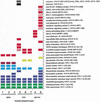Identification of new herpesvirus gene homologs in the human genome
- PMID: 12421761
- PMCID: PMC187546
- DOI: 10.1101/gr.334302
Identification of new herpesvirus gene homologs in the human genome
Abstract
Viruses are intracellular parasites that use many cellular pathways during their replication. Large DNA viruses, such as herpesviruses, have captured a repertoire of cellular genes to block or mimic host immune responses, apoptosis regulation, and cell-cycle control mechanisms. We have conducted a systematic search for all homologs of herpesvirus proteins in the human genome using position-specific scoring matrices representing herpesvirus protein sequence domains, and pair-wise sequence comparisons. The analysis shows that approximately 13% of the herpesvirus proteins have clear sequence similarity to products of the human genome. Different human herpesviruses vary in their numbers of human homologs, indicating distinct rates of gene acquisition in different lineages. Our analysis has identified new families of herpesvirus/human homologs from viruses including human herpesvirus 5 (human cytomegalovirus; HCMV) and human herpesvirus 8 (Kaposi's sarcoma-associated herpesvirus; KSHV), which may play important roles in host-virus interactions.
Figures



References
-
- Altschul SF, Gish W, Miller W, Myers EW, Lipman DJ. Basic local alignment search tool. J Mol Biol. 1990;215:403–410. - PubMed
Publication types
MeSH terms
Substances
LinkOut - more resources
Full Text Sources
